Analysis of Applicable Legal Provisions in Queensland in Case of Pregnancy Below 18 Years Age
VerifiedAdded on 2023/01/16
|6
|1829
|97
AI Summary
This document provides an analysis of the applicable legal provisions in Queensland in the case of pregnancy below 18 years of age. It discusses the necessity of parental permission and the doctor's obligation to inform parents about the pregnancy. It also explores the options available to the pregnant individual and the potential legal consequences for the health practitioner. The document further examines the civil law of torts and the Health Practitioner Regulation National Law Act.
Contribute Materials
Your contribution can guide someone’s learning journey. Share your
documents today.
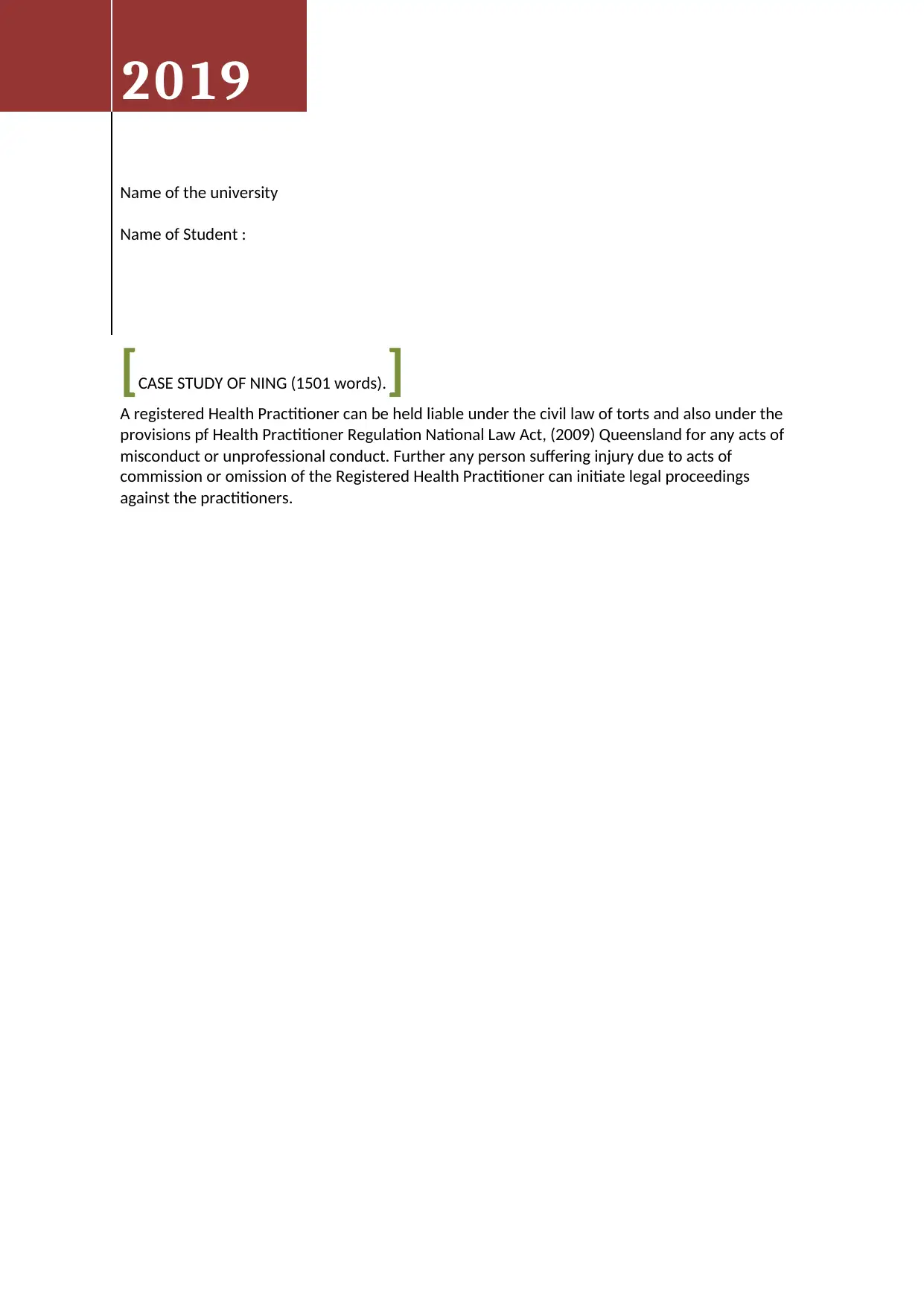
[CASE STUDY OF NING (1501 words).]
A registered Health Practitioner can be held liable under the civil law of torts and also under the
provisions pf Health Practitioner Regulation National Law Act, (2009) Queensland for any acts of
misconduct or unprofessional conduct. Further any person suffering injury due to acts of
commission or omission of the Registered Health Practitioner can initiate legal proceedings
against the practitioners.
2019
Name of the university
Name of Student :
A registered Health Practitioner can be held liable under the civil law of torts and also under the
provisions pf Health Practitioner Regulation National Law Act, (2009) Queensland for any acts of
misconduct or unprofessional conduct. Further any person suffering injury due to acts of
commission or omission of the Registered Health Practitioner can initiate legal proceedings
against the practitioners.
2019
Name of the university
Name of Student :
Secure Best Marks with AI Grader
Need help grading? Try our AI Grader for instant feedback on your assignments.

ANALYSIS OF APPLICABLE LEGAL PROVISIONS IN QUEENSLAND IN CASE OF PREGNANCY
BELOW 18 YEARS AGE.
(a) Is Parent’s permission necessary for going to a Doctor and is the Doctor required to
inform parents about pregnancy.
After examining the patient, Doctor will have to decide whether Sabrina will be able
to give her consent to medical treatment based on her age, maturity level, any
complications involved in the treatment. Alsowhether she will be able to
comprehend the entire process. If after considering all the aforesaid factors, the
Doctor is of the view that the patient is in a position to give her consent, then he can
keep this information confidential and need not even inform her parents.
However since Sabrina has been assessed as Gillick competent, the Doctor would be
of the view that that she can give her consent.
Gillick competent means that a young person is able to understand a problem, risks
and benefits of treatment and other alternative options, consequences of not taking
treatment and implications on the family. It also means that a Gillick competent
person is able to remember and weigh all pros and cons of the information received
and will be able to take a logical decision. All children of the age of 16 and above are
deemed to be Gillick competent.
(b) Options available on pregnancy.
Sabrina may opt for abortion or after the child is born give the child for adoption or
may even decide to raise the child herself.
Abortion : Since Sabrina has been pregnant for less than 22 weeks she can legally
abort, provided that the Doctor is of the opinion that she is mature enough to
understand the procedures involved.
Adoption : Both the parents have to give their consent for adoption and can change
their decision within 30 days.( Code of Professional Conduct for Nurses in Australia)
Since Sabrina is not willing to provide the name of the father, this option is ruled out.
Raising the Child on her own : Since she wants to keep her pregnancy secret,
therefore this option is also ruled out.
Since Sabrina is Gillick competent, the Doctor most likely will be of theopinion that
she is capable of taking a decision on abortion. Therefore she is not bound to inform
her parents about her pregnancy or her decision on Abortion.
BELOW 18 YEARS AGE.
(a) Is Parent’s permission necessary for going to a Doctor and is the Doctor required to
inform parents about pregnancy.
After examining the patient, Doctor will have to decide whether Sabrina will be able
to give her consent to medical treatment based on her age, maturity level, any
complications involved in the treatment. Alsowhether she will be able to
comprehend the entire process. If after considering all the aforesaid factors, the
Doctor is of the view that the patient is in a position to give her consent, then he can
keep this information confidential and need not even inform her parents.
However since Sabrina has been assessed as Gillick competent, the Doctor would be
of the view that that she can give her consent.
Gillick competent means that a young person is able to understand a problem, risks
and benefits of treatment and other alternative options, consequences of not taking
treatment and implications on the family. It also means that a Gillick competent
person is able to remember and weigh all pros and cons of the information received
and will be able to take a logical decision. All children of the age of 16 and above are
deemed to be Gillick competent.
(b) Options available on pregnancy.
Sabrina may opt for abortion or after the child is born give the child for adoption or
may even decide to raise the child herself.
Abortion : Since Sabrina has been pregnant for less than 22 weeks she can legally
abort, provided that the Doctor is of the opinion that she is mature enough to
understand the procedures involved.
Adoption : Both the parents have to give their consent for adoption and can change
their decision within 30 days.( Code of Professional Conduct for Nurses in Australia)
Since Sabrina is not willing to provide the name of the father, this option is ruled out.
Raising the Child on her own : Since she wants to keep her pregnancy secret,
therefore this option is also ruled out.
Since Sabrina is Gillick competent, the Doctor most likely will be of theopinion that
she is capable of taking a decision on abortion. Therefore she is not bound to inform
her parents about her pregnancy or her decision on Abortion.
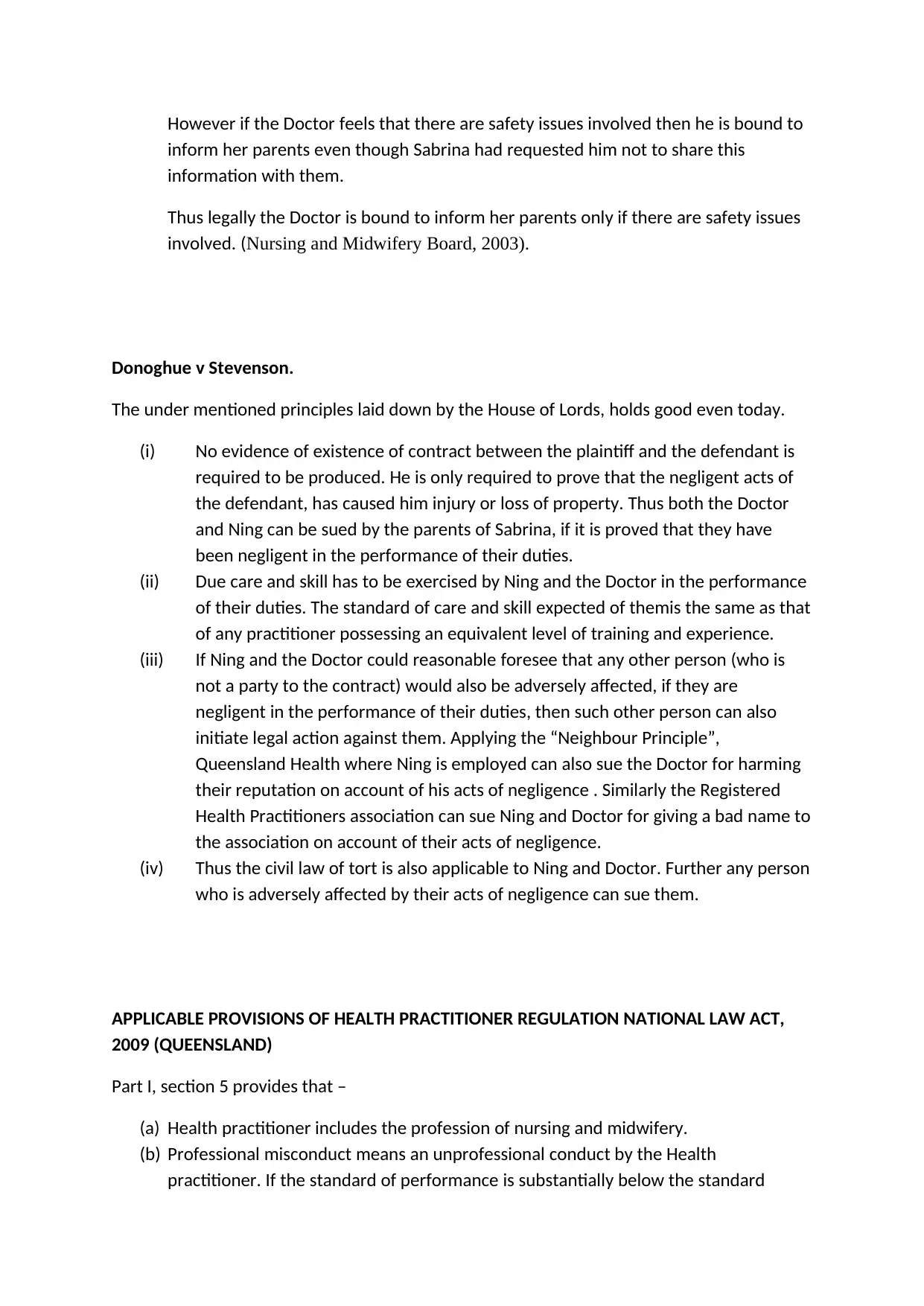
However if the Doctor feels that there are safety issues involved then he is bound to
inform her parents even though Sabrina had requested him not to share this
information with them.
Thus legally the Doctor is bound to inform her parents only if there are safety issues
involved. (Nursing and Midwifery Board, 2003).
Donoghue v Stevenson.
The under mentioned principles laid down by the House of Lords, holds good even today.
(i) No evidence of existence of contract between the plaintiff and the defendant is
required to be produced. He is only required to prove that the negligent acts of
the defendant, has caused him injury or loss of property. Thus both the Doctor
and Ning can be sued by the parents of Sabrina, if it is proved that they have
been negligent in the performance of their duties.
(ii) Due care and skill has to be exercised by Ning and the Doctor in the performance
of their duties. The standard of care and skill expected of themis the same as that
of any practitioner possessing an equivalent level of training and experience.
(iii) If Ning and the Doctor could reasonable foresee that any other person (who is
not a party to the contract) would also be adversely affected, if they are
negligent in the performance of their duties, then such other person can also
initiate legal action against them. Applying the “Neighbour Principle”,
Queensland Health where Ning is employed can also sue the Doctor for harming
their reputation on account of his acts of negligence . Similarly the Registered
Health Practitioners association can sue Ning and Doctor for giving a bad name to
the association on account of their acts of negligence.
(iv) Thus the civil law of tort is also applicable to Ning and Doctor. Further any person
who is adversely affected by their acts of negligence can sue them.
APPLICABLE PROVISIONS OF HEALTH PRACTITIONER REGULATION NATIONAL LAW ACT,
2009 (QUEENSLAND)
Part I, section 5 provides that –
(a) Health practitioner includes the profession of nursing and midwifery.
(b) Professional misconduct means an unprofessional conduct by the Health
practitioner. If the standard of performance is substantially below the standard
inform her parents even though Sabrina had requested him not to share this
information with them.
Thus legally the Doctor is bound to inform her parents only if there are safety issues
involved. (Nursing and Midwifery Board, 2003).
Donoghue v Stevenson.
The under mentioned principles laid down by the House of Lords, holds good even today.
(i) No evidence of existence of contract between the plaintiff and the defendant is
required to be produced. He is only required to prove that the negligent acts of
the defendant, has caused him injury or loss of property. Thus both the Doctor
and Ning can be sued by the parents of Sabrina, if it is proved that they have
been negligent in the performance of their duties.
(ii) Due care and skill has to be exercised by Ning and the Doctor in the performance
of their duties. The standard of care and skill expected of themis the same as that
of any practitioner possessing an equivalent level of training and experience.
(iii) If Ning and the Doctor could reasonable foresee that any other person (who is
not a party to the contract) would also be adversely affected, if they are
negligent in the performance of their duties, then such other person can also
initiate legal action against them. Applying the “Neighbour Principle”,
Queensland Health where Ning is employed can also sue the Doctor for harming
their reputation on account of his acts of negligence . Similarly the Registered
Health Practitioners association can sue Ning and Doctor for giving a bad name to
the association on account of their acts of negligence.
(iv) Thus the civil law of tort is also applicable to Ning and Doctor. Further any person
who is adversely affected by their acts of negligence can sue them.
APPLICABLE PROVISIONS OF HEALTH PRACTITIONER REGULATION NATIONAL LAW ACT,
2009 (QUEENSLAND)
Part I, section 5 provides that –
(a) Health practitioner includes the profession of nursing and midwifery.
(b) Professional misconduct means an unprofessional conduct by the Health
practitioner. If the standard of performance is substantially below the standard
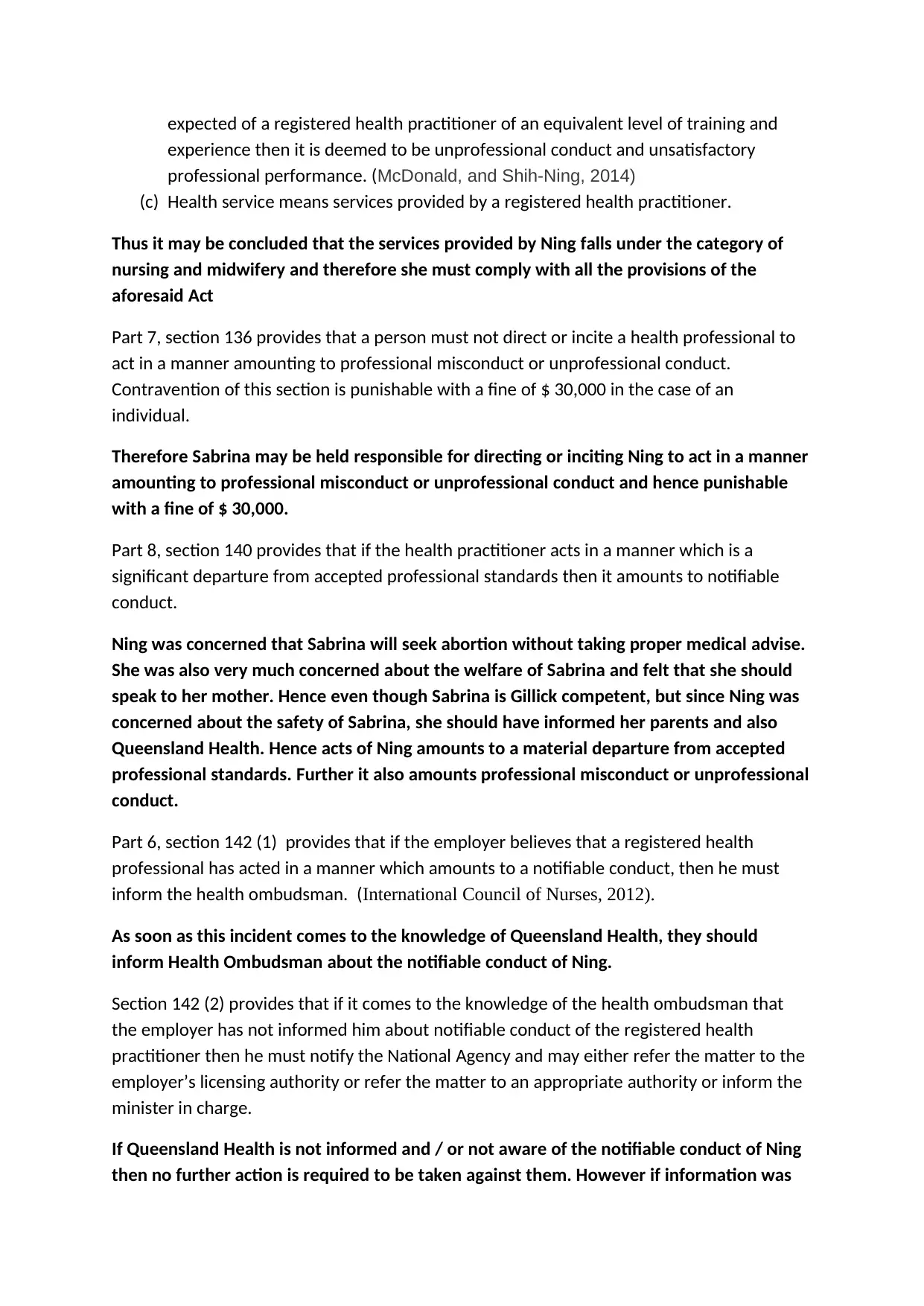
expected of a registered health practitioner of an equivalent level of training and
experience then it is deemed to be unprofessional conduct and unsatisfactory
professional performance. (McDonald, and Shih-Ning, 2014)
(c) Health service means services provided by a registered health practitioner.
Thus it may be concluded that the services provided by Ning falls under the category of
nursing and midwifery and therefore she must comply with all the provisions of the
aforesaid Act
Part 7, section 136 provides that a person must not direct or incite a health professional to
act in a manner amounting to professional misconduct or unprofessional conduct.
Contravention of this section is punishable with a fine of $ 30,000 in the case of an
individual.
Therefore Sabrina may be held responsible for directing or inciting Ning to act in a manner
amounting to professional misconduct or unprofessional conduct and hence punishable
with a fine of $ 30,000.
Part 8, section 140 provides that if the health practitioner acts in a manner which is a
significant departure from accepted professional standards then it amounts to notifiable
conduct.
Ning was concerned that Sabrina will seek abortion without taking proper medical advise.
She was also very much concerned about the welfare of Sabrina and felt that she should
speak to her mother. Hence even though Sabrina is Gillick competent, but since Ning was
concerned about the safety of Sabrina, she should have informed her parents and also
Queensland Health. Hence acts of Ning amounts to a material departure from accepted
professional standards. Further it also amounts professional misconduct or unprofessional
conduct.
Part 6, section 142 (1) provides that if the employer believes that a registered health
professional has acted in a manner which amounts to a notifiable conduct, then he must
inform the health ombudsman. (International Council of Nurses, 2012).
As soon as this incident comes to the knowledge of Queensland Health, they should
inform Health Ombudsman about the notifiable conduct of Ning.
Section 142 (2) provides that if it comes to the knowledge of the health ombudsman that
the employer has not informed him about notifiable conduct of the registered health
practitioner then he must notify the National Agency and may either refer the matter to the
employer’s licensing authority or refer the matter to an appropriate authority or inform the
minister in charge.
If Queensland Health is not informed and / or not aware of the notifiable conduct of Ning
then no further action is required to be taken against them. However if information was
experience then it is deemed to be unprofessional conduct and unsatisfactory
professional performance. (McDonald, and Shih-Ning, 2014)
(c) Health service means services provided by a registered health practitioner.
Thus it may be concluded that the services provided by Ning falls under the category of
nursing and midwifery and therefore she must comply with all the provisions of the
aforesaid Act
Part 7, section 136 provides that a person must not direct or incite a health professional to
act in a manner amounting to professional misconduct or unprofessional conduct.
Contravention of this section is punishable with a fine of $ 30,000 in the case of an
individual.
Therefore Sabrina may be held responsible for directing or inciting Ning to act in a manner
amounting to professional misconduct or unprofessional conduct and hence punishable
with a fine of $ 30,000.
Part 8, section 140 provides that if the health practitioner acts in a manner which is a
significant departure from accepted professional standards then it amounts to notifiable
conduct.
Ning was concerned that Sabrina will seek abortion without taking proper medical advise.
She was also very much concerned about the welfare of Sabrina and felt that she should
speak to her mother. Hence even though Sabrina is Gillick competent, but since Ning was
concerned about the safety of Sabrina, she should have informed her parents and also
Queensland Health. Hence acts of Ning amounts to a material departure from accepted
professional standards. Further it also amounts professional misconduct or unprofessional
conduct.
Part 6, section 142 (1) provides that if the employer believes that a registered health
professional has acted in a manner which amounts to a notifiable conduct, then he must
inform the health ombudsman. (International Council of Nurses, 2012).
As soon as this incident comes to the knowledge of Queensland Health, they should
inform Health Ombudsman about the notifiable conduct of Ning.
Section 142 (2) provides that if it comes to the knowledge of the health ombudsman that
the employer has not informed him about notifiable conduct of the registered health
practitioner then he must notify the National Agency and may either refer the matter to the
employer’s licensing authority or refer the matter to an appropriate authority or inform the
minister in charge.
If Queensland Health is not informed and / or not aware of the notifiable conduct of Ning
then no further action is required to be taken against them. However if information was
Secure Best Marks with AI Grader
Need help grading? Try our AI Grader for instant feedback on your assignments.
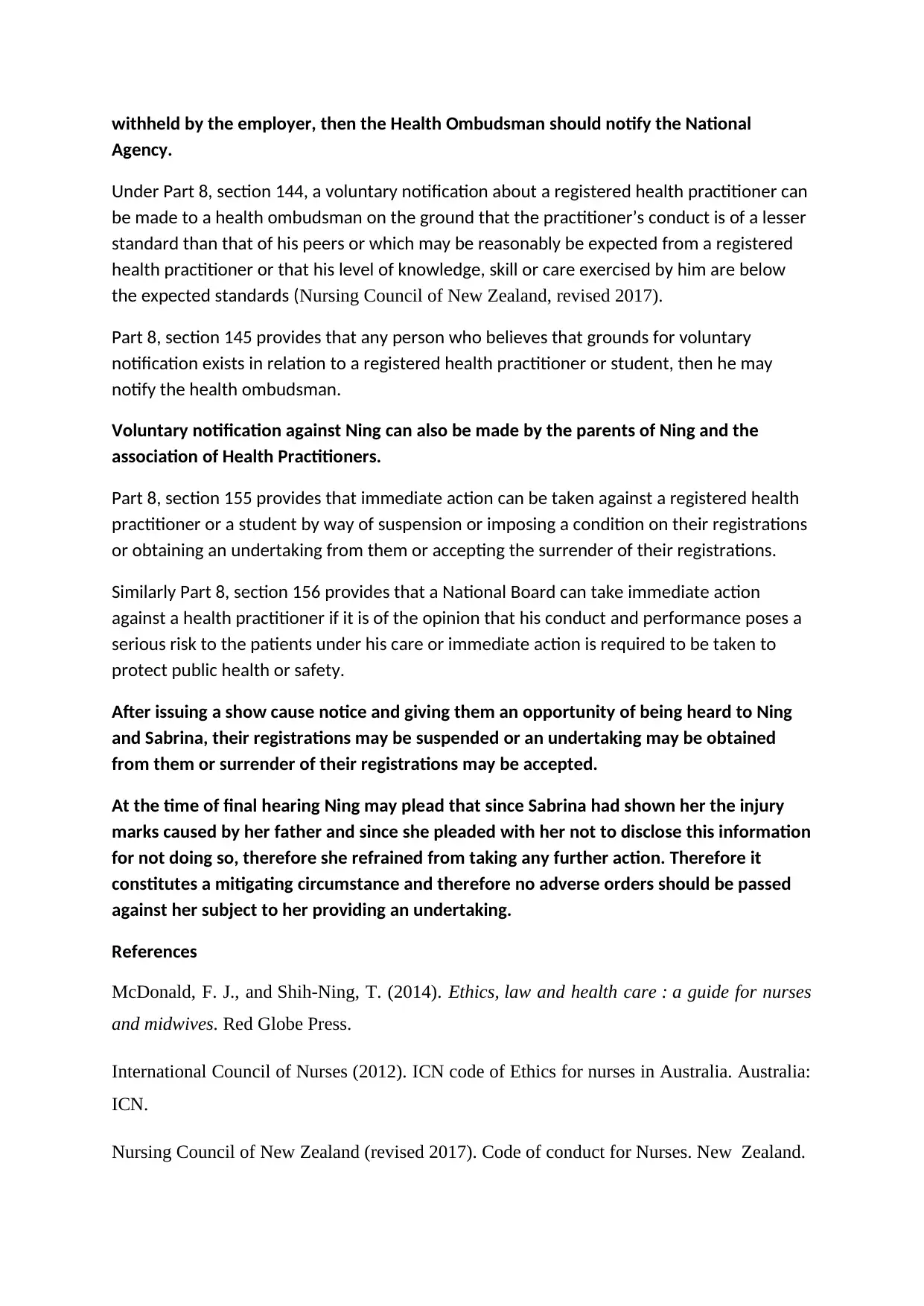
withheld by the employer, then the Health Ombudsman should notify the National
Agency.
Under Part 8, section 144, a voluntary notification about a registered health practitioner can
be made to a health ombudsman on the ground that the practitioner’s conduct is of a lesser
standard than that of his peers or which may be reasonably be expected from a registered
health practitioner or that his level of knowledge, skill or care exercised by him are below
the expected standards (Nursing Council of New Zealand, revised 2017).
Part 8, section 145 provides that any person who believes that grounds for voluntary
notification exists in relation to a registered health practitioner or student, then he may
notify the health ombudsman.
Voluntary notification against Ning can also be made by the parents of Ning and the
association of Health Practitioners.
Part 8, section 155 provides that immediate action can be taken against a registered health
practitioner or a student by way of suspension or imposing a condition on their registrations
or obtaining an undertaking from them or accepting the surrender of their registrations.
Similarly Part 8, section 156 provides that a National Board can take immediate action
against a health practitioner if it is of the opinion that his conduct and performance poses a
serious risk to the patients under his care or immediate action is required to be taken to
protect public health or safety.
After issuing a show cause notice and giving them an opportunity of being heard to Ning
and Sabrina, their registrations may be suspended or an undertaking may be obtained
from them or surrender of their registrations may be accepted.
At the time of final hearing Ning may plead that since Sabrina had shown her the injury
marks caused by her father and since she pleaded with her not to disclose this information
for not doing so, therefore she refrained from taking any further action. Therefore it
constitutes a mitigating circumstance and therefore no adverse orders should be passed
against her subject to her providing an undertaking.
References
McDonald, F. J., and Shih-Ning, T. (2014). Ethics, law and health care : a guide for nurses
and midwives. Red Globe Press.
International Council of Nurses (2012). ICN code of Ethics for nurses in Australia. Australia:
ICN.
Nursing Council of New Zealand (revised 2017). Code of conduct for Nurses. New Zealand.
Agency.
Under Part 8, section 144, a voluntary notification about a registered health practitioner can
be made to a health ombudsman on the ground that the practitioner’s conduct is of a lesser
standard than that of his peers or which may be reasonably be expected from a registered
health practitioner or that his level of knowledge, skill or care exercised by him are below
the expected standards (Nursing Council of New Zealand, revised 2017).
Part 8, section 145 provides that any person who believes that grounds for voluntary
notification exists in relation to a registered health practitioner or student, then he may
notify the health ombudsman.
Voluntary notification against Ning can also be made by the parents of Ning and the
association of Health Practitioners.
Part 8, section 155 provides that immediate action can be taken against a registered health
practitioner or a student by way of suspension or imposing a condition on their registrations
or obtaining an undertaking from them or accepting the surrender of their registrations.
Similarly Part 8, section 156 provides that a National Board can take immediate action
against a health practitioner if it is of the opinion that his conduct and performance poses a
serious risk to the patients under his care or immediate action is required to be taken to
protect public health or safety.
After issuing a show cause notice and giving them an opportunity of being heard to Ning
and Sabrina, their registrations may be suspended or an undertaking may be obtained
from them or surrender of their registrations may be accepted.
At the time of final hearing Ning may plead that since Sabrina had shown her the injury
marks caused by her father and since she pleaded with her not to disclose this information
for not doing so, therefore she refrained from taking any further action. Therefore it
constitutes a mitigating circumstance and therefore no adverse orders should be passed
against her subject to her providing an undertaking.
References
McDonald, F. J., and Shih-Ning, T. (2014). Ethics, law and health care : a guide for nurses
and midwives. Red Globe Press.
International Council of Nurses (2012). ICN code of Ethics for nurses in Australia. Australia:
ICN.
Nursing Council of New Zealand (revised 2017). Code of conduct for Nurses. New Zealand.
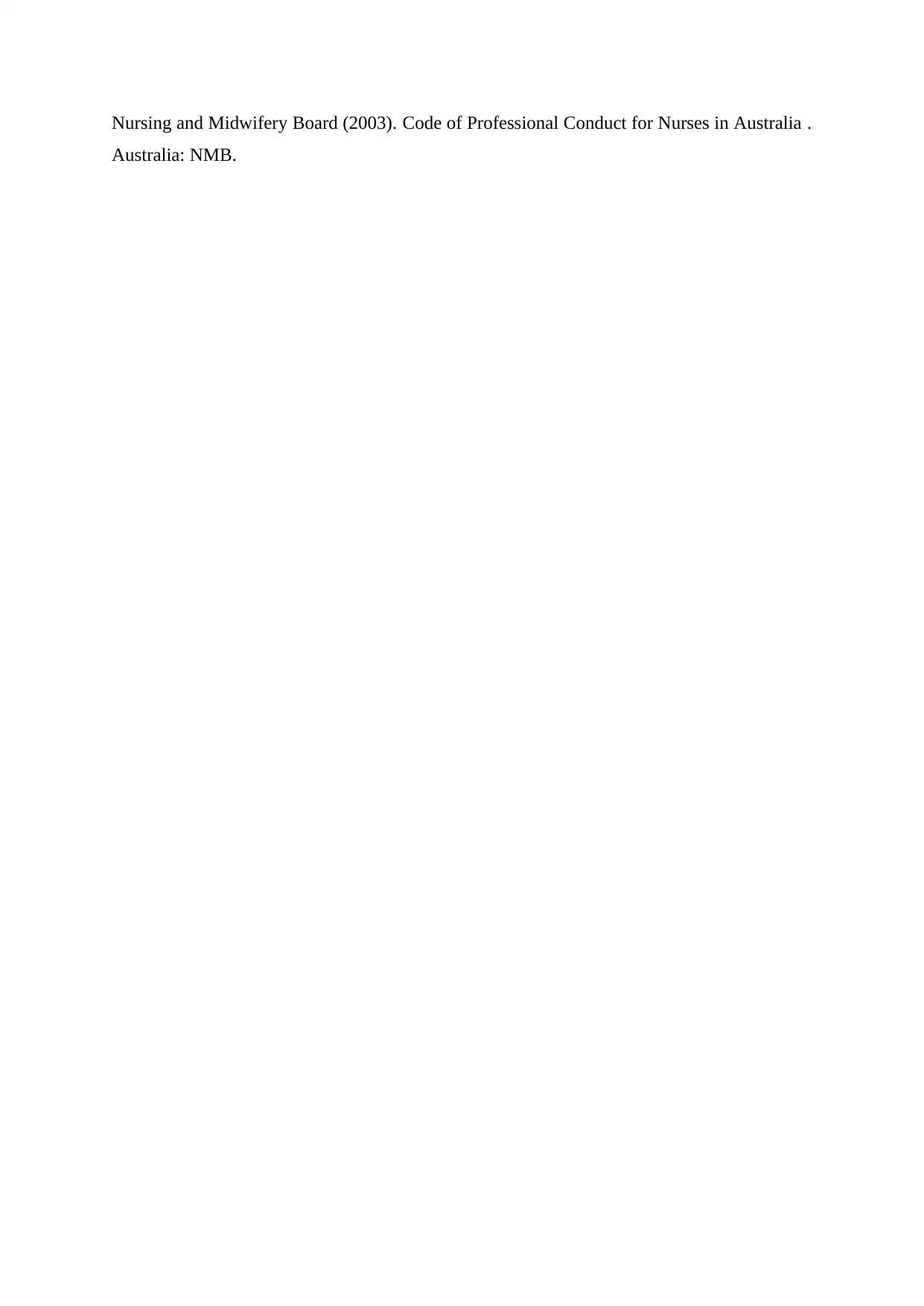
Nursing and Midwifery Board (2003). Code of Professional Conduct for Nurses in Australia .
Australia: NMB.
Australia: NMB.
1 out of 6
Related Documents
Your All-in-One AI-Powered Toolkit for Academic Success.
+13062052269
info@desklib.com
Available 24*7 on WhatsApp / Email
![[object Object]](/_next/static/media/star-bottom.7253800d.svg)
Unlock your academic potential
© 2024 | Zucol Services PVT LTD | All rights reserved.





